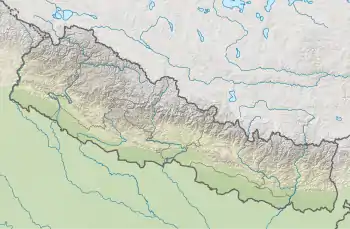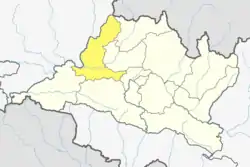Siddhalek Rural Municipality
Siddhalek is a rural municipality located within the Dhading District of the Bagmati Province of Nepal. The rural municipality spans 106.09 square kilometres (40.96 sq mi), with a total population of 23,729 according to a 2011 Nepal census.[1][2]
Siddhalek
सिद्धलेक गाउँपालिका | |
|---|---|
 Siddhalek Location of rural council  Siddhalek Siddhalek (Nepal) | |
| Coordinates: 27.84°N 84.81°E | |
| Country | |
| Province | Bagmati |
| District | Dhading |
| Wards | 7 |
| Established | 10 March 2017 |
| Government | |
| • Type | Rural Council |
| • Chairperson | Mr. Premnath Silwal |
| • Vice-chairperson | Mrs. Kamla Sharma |
| Area | |
| • Total | 106.09 km2 (40.96 sq mi) |
| Population (2011) | |
| • Total | 23,729 |
| • Density | 220/km2 (580/sq mi) |
| Time zone | UTC+5:45 (Nepal Standard Time) |
| Headquarter | Salang |
| Website | siddhalekmun |
On March 10, 2017, the Government of Nepal restructured the local level bodies into 753 new local level structures.[3][4] The previous Nalang, Salang, and Kumpur VDCs were merged to form Siddhalek. Siddhalek is divided into 7 wards, with Salang declared the administrative center of the rural municipality.
Demographics
At the time of the 2011 Nepal census, Siddhalek Rural Municipality had a population of 23,729. Of these, 86.4% spoke Nepali, 10.8% Magar, 1.3% Tamang, 0.8% Gurung, 0.2% Ghale, 0.2% Majhi, 0.2% Newar, 0.1% Urdu and 0.1% other languages as their first language.[5]
In terms of ethnicity/caste, 19.6% were Magar, 18.3% Hill Brahmin, 16.5% Newar, 9.5% Sarki, 7.1% Chhetri, 6.2% Ghale, 5.0% Kami, 4.2% Sanyasi/Dasnami, 3.8% Damai/Dholi, 3.2% Gurung, 1.6% Gharti/Bhujel, 1.5% Tamang, 1.3% Majhi, 0.9% Thakuri, 0.6% Brahmu/Baramo, 0.1% Chepang/Praja,, 0.1% Gaine, 0.1% Limbu, 0.1% Musalman, 0.1% Rai, 0.1% other Terai and 0.2% others.[6]
In terms of religion, 94.4% were Hindu, 4.0% Buddhist, 1.4% Christian, 0.1% Muslim and 0.1% others.[7]
In terms of literacy, 64.4% could both read and write, 3.1% could read but not write and 32.5% could neither read nor write.[8]
References
- "District Corrected Last for RAJAPATRA" (PDF). www.mofald.gov.np. Retrieved 17 July 2018.
- "स्थानीय तहहरुको विवरण" [Details of the local level bodies]. www.mofald.gov.np/en (in Nepali). Ministry of Federal Affairs and Local Development. Retrieved 17 July 2018.
- "New local level structure comes into effect from today". www.thehimalayantimes.com. The Himalayan Times. 10 March 2017. Retrieved 17 July 2018.
- "New local level units come into existence". www.kathmandupost.ekantipur.com. 11 March 2017. Retrieved 18 July 2018.
- NepalMap Language
- NepalMap Caste
- NepalMap Religion
- NepalMap Literacy
